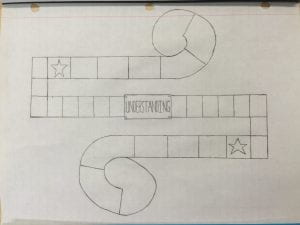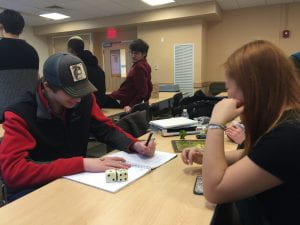For this artwork project, I decided to make a game that simulates the process of understanding another person’s emotions and learning how to detect them, so as to avoid making incorrect assumptions that will be detrimental to the relationship.
This game requires two players, a deck of “Emoticards,” and a simple game board consisting of 31 tiles. One player is a drawing player who draws from the deck of “Emoticards” and the other player is a reading player who attempts to read the expression of the drawing player and accurately guess the emotion they are displaying. The deck of “Emoticards” contains 9 unique emotions that the drawing player has to portray with their facial expressions, and there are multiple copies of each card so as to provide repetition and allow for the reading player to learn from the drawing player. Pictures of the game board and “Emoticards” can be found at the bottom of this post.
Each player starts with their piece on one of the respective stars, and the game is won when both players have advanced to the middle “Understanding” tile; alternatively, both players lose if they regress to the last available tile on the board. At the start of a turn, the drawing player will draw an “Emoticard” from the random deck and create a facial expression of the given emotion. Upon seeing the facial expression, the reading player will either guess the emotion or declare, “I don’t know.” If the guessed emotion is correct, both players advance one tile towards the center. If the guessed emotion is incorrect, both players regress one tile away from the center. If no emotion is guessed, neither player moves.
I drew a lot of the concept of this game from our in-class discussions, especially when we had the guest speaker Ichiro Lambe come in and talk about his process as a rising Indie game developer. I was really interested in the dynamic that occurs between a game developer and a tester, and since I know more about emotional relationships than game testing, I decided to combine what I knew with the process Ichiro was describing to create this finished product. An interesting fun game that is similarly avant-garde in nature is What?!? Oh…, a card game that uses conversation cards and action cards to create a funny dialog between two or more people. My game draws from the same idea of combining actions with dialog, but does it in a slightly different way by allowing the players to decide the action (facial expression) rather than being instructed on how to portray it. In terms of where my game fits on the Shrank Avant-garde diagram, I placed it just slightly to the bottom and left of the center crosshairs which makes it slightly more political and complicit than radical and formal. This was my placement because the game is supposed to make the players think about their everyday actions in a different way and ultimately change the way they interact with people in life.
Game Board:

Emoticards:
Documentation: I have only played this game all the way through three times with friends, however I have changed several key aspects so as to fine tune it to be more playable. One big aspect that I changed was how players would express their emoticards. Prior to allowing players express the emoticard freely, I had instructions on the card of how to form the given facial expression and that ended up causing more trouble than benefits in the game. Another change I had to make was with the size the game board. Originally, I required each player to advance 5 spaces to win and only allowed 4 spaces to lose, which ended up with players either winning too quickly or losing too quickly, and ultimately ended up making the game shorter than I intended. Since the change, both players must now advance 9 spaces to win and are only allowed 6 spaces to lose. This results in a more strategic game play and influences players to think more about the meaning behind the game. Here is a link of the old game board, and a photo of my friend Matt playing it.




